By Pauline Weston Thomas for Fashion-Era.com
- Vintage Lace
- Types of Vintage Lace
- Needlepoint Lace
- Needlepoint Lace Types
- Brussels Lace
- Edwardian Mixed Lace Gown
- Bobbin Lace
- Valenciennes Handkerchief
- Minor_Lace_Techniques
- Whitework
- Edwardian Cutwork Jacket
- Tape Vintage Laces
- Filet Vintage Lace
- Crochet
- Irish Crochet Bonnet
- Edwardian Irish Crochet Gown
- Macramé
Vintage Lace
There are many many types of lace and lace comes under the classification of non loom textiles.
Lace is the most recent of traditional textile techniques to come into being. Lace in the form we know today is thought to have originated in Europe in the Adriatic region in the 1400s. Methods of working spread far and wide rapidly. Soon lace making was an art craft done by both professionals and amateurs and found throughout Europe from the outermost parts of Russia to England and Ireland. Hand made lace was a fashion item which spoke volumes because it was always expensive.
By 1818 machinery existed to make lace, but handcrafted lace was still practised in Eastern Europe especially in the Baltic region. Lace is often combined in pieces with whitework embroidery or drawn-thread work and the combinations often make wonderful articles for vintage enthusiasts to collect.
Identifying lace is a field in itself and many vintage sellers often take their lace or send photographs to experts for identification of difficult pieces. The best advice I can give you, is to obtain a modern book on lace naming such as that by Helen Toomer which gives a very clear identification of old lace techniques and types. You can also browse a few of the excellent website pages I suggest here.
In simple terms some descriptions can be arrived at by these classifications below.
Types of Vintage Lace
Basically, lace can be divided into 3 types
- Needle Made Lace also called Needlepoint Lace
- Bobbin Lace
- Machine Made Lace
In addition Tape laces, Tatting, Knitting, Crochet and Macramé are classified as minor techniques that create openwork decorative fabrics. Whitework is frequently bundled together with lace goods as cutwork and openwork, since both frequently achieve lace like effects. There is no point in my duplicating what I believe to be the best pictorial reference illustrating the main varieties of other work which interests lace collectors already here at http://www.marlamallett.com/l-other.htm
Machine made lace sets out to imitate hand made laces. Because of this books on lace identification concentrate on hand made laces and distinguishing between bobbin made lace and needlepoint lace. To complicate matters further some lace is made using a combination of the two hand methods and also may incorporate whitework and perhaps Irish crochet.
You can only hope to begin to identify lace and therefore develop experience by using good reference books and/or museum study for comparison purposes.
Machine made lace deliberately sets out to deceive and one place to see original pattern books and examples for machine made lace is in the fine converted Church now known as the Lace Hall in Nottingham city. The Lace hall Museum is at High Pavement, Nottingham, England UK.
Needlepoint Vintage Lace
Needlepoint Lace is made entirely with a needle and thread and developed in the 1400s whereas bobbin lace is thought to have developed in the 1600s.
Needlemade vintage lace in brief is made when foundation threads are secured to a paper pattern that is already tacked to 2 layers of foundation fabric. The foundation threads are couched into position with further threads through every layer of the paper and the fabric.
When the pattern is in position the excess fabric is removed and the real build up of the lace with needlework begins. Using mainly buttonhole stitch, design motifs are filled in with needlework stitching, including short linking bars, picots and loops.
The huge variety of open or closed stitch work and filling stitches is what gives such a range of individual variation within needle made lace. It is much, much more complex than this, but this is sufficient explanation here.
To add further complication sometimes bobbin made grounds or machine made net grounds are used as a base for the needle made motifs.
Needlepoint Laces Include the Following Types:
An openwork style includes Reticella whereas a Guipure style includes Punto in Aria, Flemish needlepoint, Venetian needlepoint and French needlepoint (Point de France). More mesh like needlepoints are Alençon, Argentan and the net grounded needlepoint lace called Burano.
Brussels Lace a popular vintage lace, is a needlepoint lace, but uses several various base grounds including a bobbin made net ground.
This application of needle made motifs to a net based ground, meant that when machine net was introduced the Brussels workers adapted to working with the new material better than the French workers, developing mixed skills to a high art form thus staying in employment.
Brussels Lace Collar
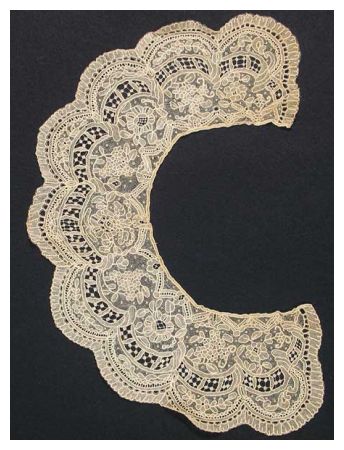
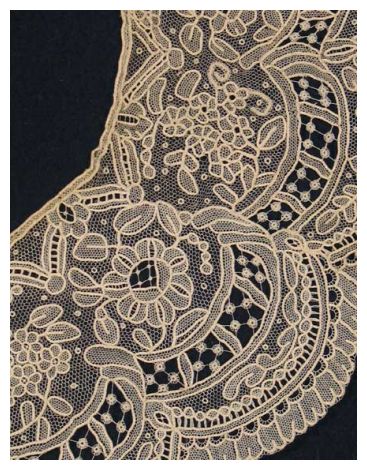
This beautiful lace collar from contentmentfarm antiques is hand made Brussels lace, one of the most sophisticated and loved laces in the world.
This collar is exceptional in detail and workmanship featuring floral and scroll motifs. Each motif is beautifully outlined in heavier thread giving a three dimensional effect
Machine made net started to be manufactured by the 1820s and by the 1850s bobbin net grounds had been superseded by the lighter point de gaze ground nets, which generally changed the look of the lace, combined with the fact that less area was covered with clothwork.
As the Victorian era progressed, the Brussels workers of the 1850s and 1860s produced more assured designs in the new style creating a sought after lace type. The lace continued to develop and change often being used for wedding trousseaux, but began to wane as the century ended.
By the 1920s the fashion for this type of lace died out as simpler less ornate more stylised art deco forms of decoration on dress, particularly beading and appliqué became the rage.
Brussels point de gaze lace was often produced as parures or sets of lace especially for a Victorian wedding trousseau. A wedding lace parure might contain some flounces ten and eight feet in length, matching edge pieces, cuffs and sleeves all with obvious matching pattern elements giving a harmony to the set. Typical depth of the widest flounce might have been 11 inches.
Edwardian Mixed Lace Gown
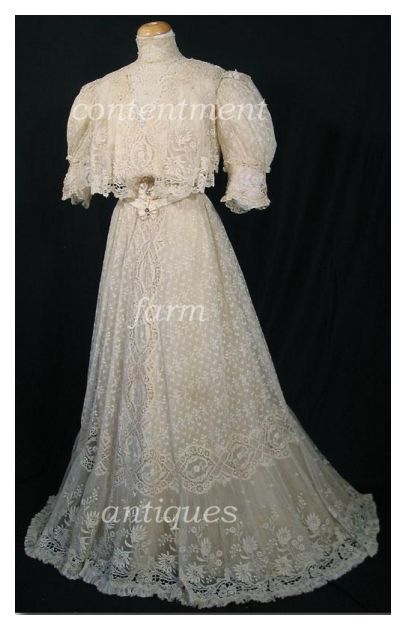
This dress from contentment farm is a lovely early Edwardian era, mixed lace wedding or dinner gown. The laces are handmade and the embroidery is hand done. It has a feature high stand-up dog collar of the Cluny lace.

Bobbin Lace
Bobbin lace probably began as a simple flat straight plaited woven braid made by interlacing threads in geometric patterns. The threads were manipulated from the bobbin pins made of carved bone, ivory or wood, to which the thread was wound. As time moved on so the pattern formation became more complex, creating more and more intricate edgings.
There are many types of bobbin lace including Flemish, Milanese, Venetian and North Italian varieties and imitations which are accepted in their own right.
In the case of lace, imitation is often inspiration for another land and frequently the fresh idea is then reworked by the original source land creating even more variations. Within these bobbin lace types are specific styles such as Italian Baroque and Flemish Baroque, Brabant, Honiton and even a Russian style which developed from Northern Italian bobbin laces. Brussels also mixed needlepoint with bobbin lace to exquisite effect making it a much prized lace.
Those from Britain include Honiton lace of Devon as well as East Midlands lace which includes Buckinghamshire Point and Bedfordshire Guipure.
In addition there are other continental varieties which are wonderful such as Valenciennes,Maltese, Mechlin, Le Puy and Lille lace. Most famous of course is Chantilly lace with its related Blonde laces (sometimes worked in black) being very important. The beautiful lace is so marvellous that it has been immortalized in well known love songs.
Valenciennes Handkerchief
This exquisite Victorian handkerchief Antique is tissue thin cotton batiste with a bow and flowers embroidered in one corner.
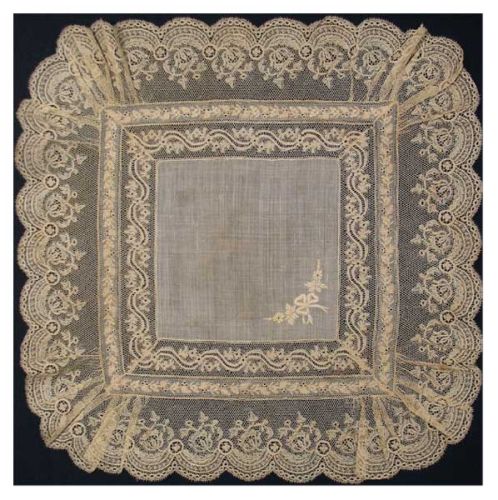
It is surrounded with a 1.25" wide border of hand made Valenciennes lace, then a hand embroidered band edged with a 3" wide hand made Valenciennes lace flounce. The work is so fine that it is almost impossible to tell the front from the back without close study.
One aspect of old lace making that is hard to reproduce today even by skilled amateurs is the fineness of the thread used. It is the fineness of the threads which gives lace its delicacy. In the Victorian era the threads used were just a few fibres thick with a count of over 1100 enabling up to 800 bobbins to be plied to create a lace just 4 inches wide.
The count of the finest threads used today is a much coarser 320. To understand this take two reels of modern sewing thread and note the count number printed on the reel label, so that one reel is 40 or 50 and the second reel has a count of 60.
You will notice how much finer the thread with a count of 60 appears. So imagine how much finer a thread of 320 might be and even far finer than that, a thread of 1100 or 1200. Far finer than a human hair or strand of a yarn from modern pantyhose I suspect.
By the 1840s machine made lace was making inroads into the hand lace-making industries. By the 1880s chemical lace which mimicked guipures was being produced at an affordable price and by 1914 less fancy clothing altogether became the norm.
(Page Date 14 Mar 2005)
Minor Vintage Lace Techniques
These are not so minor as the name suggests and are the laces many of us are familiar with typically found decorating old clothes and vintage goods.
Whitework
There are many types of whitework, but 3 main methods are usual, including openwork, cutwork and classic whitework.
- Openwork draws and pulls threads. Norwegian hardanger comes in this category.
- Cutwork involves cutting out fabric shapes from the background and then neatening the edges in a decorative manner. Broderie Anglaise and Italian Reticella are both cutwork methods of whitework.
- Classic whitework uses white embroidery stitching of various depths to create soft and darker shadows. This is often down on exceptionally fine cottons such as fine linen, batiste, muslin, organdie or on nets. Typical classic whitework includes Irish Carrickmacross, Scottish Ayrshire which uses pulled threads with embroidery, Dresden and Chikan a floral variety of patterning from India (Lucknow).
Edwardian Cutwork Jacket
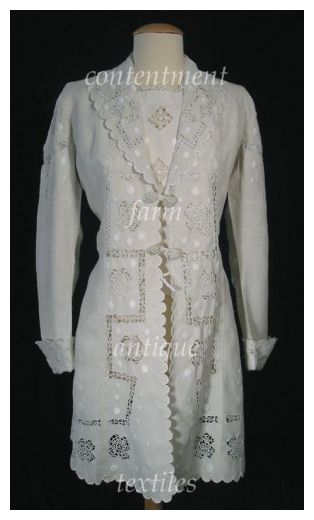
Left - An Edwardian era linen jacket and blouse heavily embellished with cutwork and white embroidery makes this an outstanding set.
The jacket is a tailored style with turned back cuffs and embroidered scalloped edges around all the edges.
The embroidered decoration is found on the collar, cuffs, either side of the front opening, along the hemline as well as on the upper back and shoulders of each sleeve.
Victorian Fichu
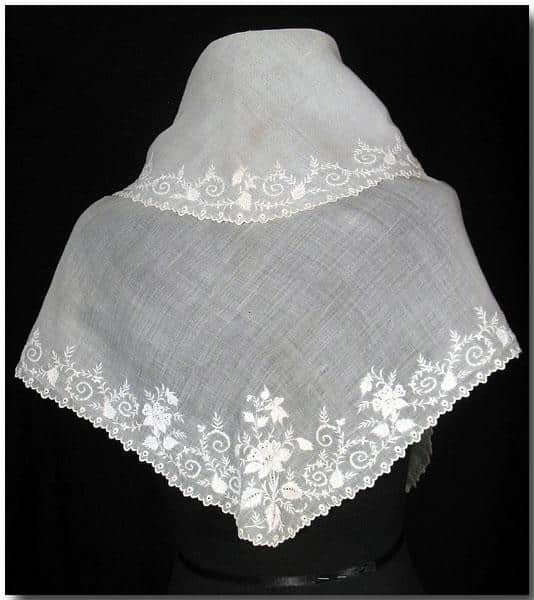
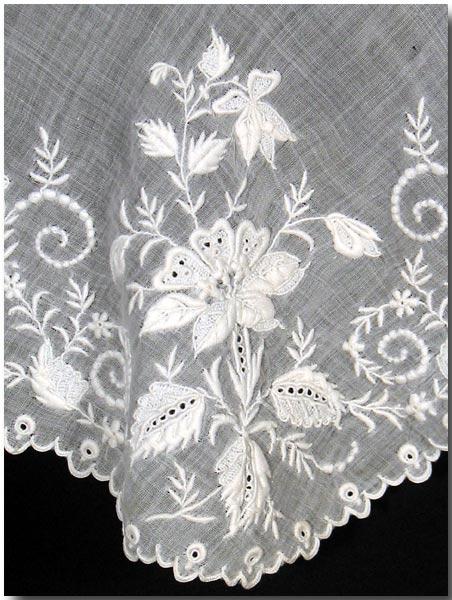
Above Civil War Era Whitework Fichu. Near right - Beautifully hand embroidered handkerchief linen lady's fichu intended to worn folded as a shawl.
Tape Vintage Laces
Many individuals will recognise a piece of tape lace and this is the easiest lace for amateurs to make as a hobby. Through the centuries tape lace has had several names including, mezzo punto, Renaissance lace and more recently the coarser Brussels tape known as Battenburg.
Luxeuil is also famous for tape lace. This is a comparatively quick method of producing lace fabrics using pre made tape lengths mostly now made by machine. The lengths of narrow tape are joined together with connecting hand stitches, worked in an open manner.
Machine made tapes have more folded kinks in them because they don't easily navigate corners. Some tapes have a thread running down one side which can pulled to help it curve more. Bobbin-made tapes being hand made are usually designed to curve corners more naturally. Washing the item usually reveals differences as machine made laces don't lie so flat after laundering.
One step away from this type of lace fabric is faggotting which uses rouleau tubes of fabric then joins these together with stitches. This creates a lacey effect which can be heavy or fine dependant on the fabric used to make the tubes. In all cases the tapes or rouleaux are tacked to sturdy paper in a pattern formation and the stitches worked between the tapes.
Filet Vintage Lace
Filet lace is a knotted mesh like net and on this mesh patterns are darned to create lace like effects. At first the mesh ground was made by hand, but by the Victorian era the ground was mostly machine made and hobbyists filled in the ground net with the more enjoyable task of decorative stitching.
Italian Burato (quite different from Venetian Burano needlepoint) is a square mesh filet filled with filet lace which can sometimes be coloured.
Crochet
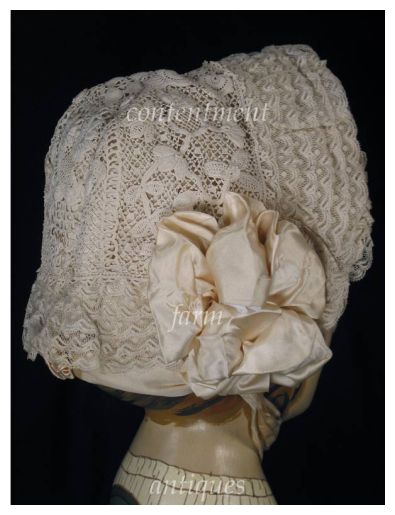
Crochet is a chain technique made by catching loops on each other with a crochet hook. Each loop is pulled through another so the whole becomes a chain.
The chain is worked into with even more loops one at a time and a fabric forms as chains build up.
Pieces can be worked in one continuous thread interlocking on itself and forming a fabric made of chains. The looping arrangements can be doubled and trebled and this creates areas which are more solid or more loopy and lace like in effect or raised to create rich areas of texture.
The yarn thread used is important in achieving a particular end result. Crochet is a simple, fast, easy and transportable technique.
Probably the most famous crochet technique is Irish Crochet
Irish Crochet Bonnet
This Victorian child's bonnet is encased in hand made Irish crochet lace. The Irish crochet is extremely detailed and a riot of flowers and vines. Overall, this is a wonderful piece that would be appropriate for a larger doll or display purposes.
Irish Crochet
Irish Crochet is a lace like fabric formed from chain stitches made with the use of a hooked crochet needle. Its design began in the 1840s and was an attempt to imitate Venetian laces and ultimately the rose style Venetian laces which had a raised guipure form. Irish crochet was hugely successful as a lace type and spread way beyond Ireland and County Cork and was copied widely throughout Europe. These skills were often taken to America too and patterns were reproduced in magazines like Petersons. It has been used for all types of goods from baby's bonnets to dresses, coats and bedspreads.
Edwardian Irish Crochet Gown
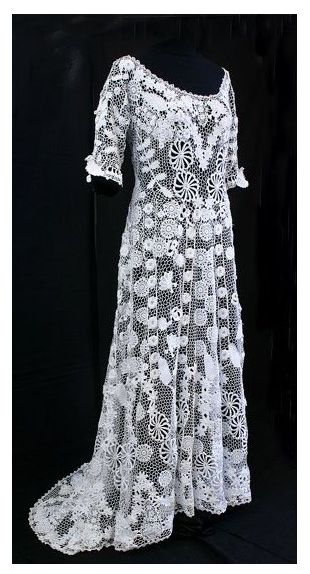
Right - Irish crochet lace gown, c.1905. The best of the art of raised crochet.
This gown has large three-dimensional motifs; a variety of motifs and a pleasing arrangement falling into a slight trained skirt. The quality of this beautiful dress is exceptional!
Macramé
Macramé is an ancient knotting technique which reached Europe in the 8th century when the Moors brought it from the near east.
From Europe sailors took the craft all over the world. In the 19th century it gained in popularity and has moved in and out of fashion ever since. It can be used to create fringes, braids and tassels, bags, belts, chair backs and hammocks.
Conclusion - Collecting Your Vintage Lace
Many of these lace techniques are being kept alive by small groups of enthusiasts or lone individuals with a passion for lace.
The internet has also provided individuals with an opportunity to trade in vintage lace pieces which the experienced eye can often use as a pattern to re-establish the older pattern form. But lace is delicate and special and those pieces that have survived have been kept because they were special and glorious and valued.
So if you plan to wear your vintage lace remember to treat it with care, storing it well and carefully.
(Page Date 14 Mar 2005)